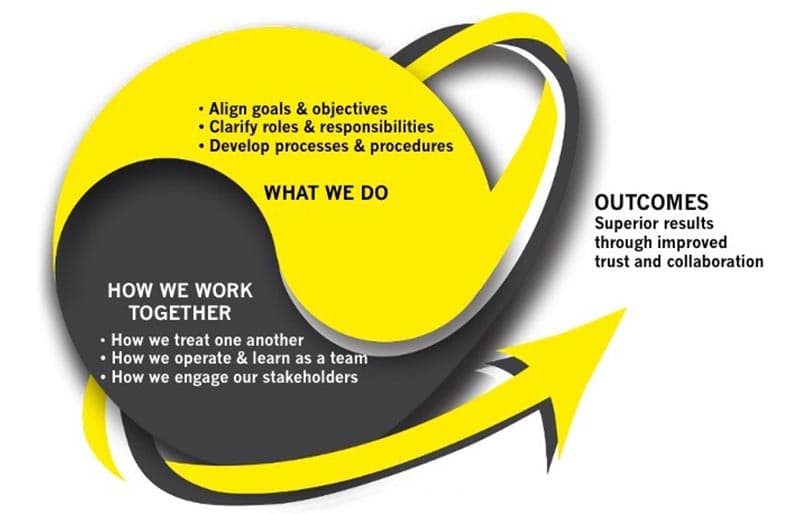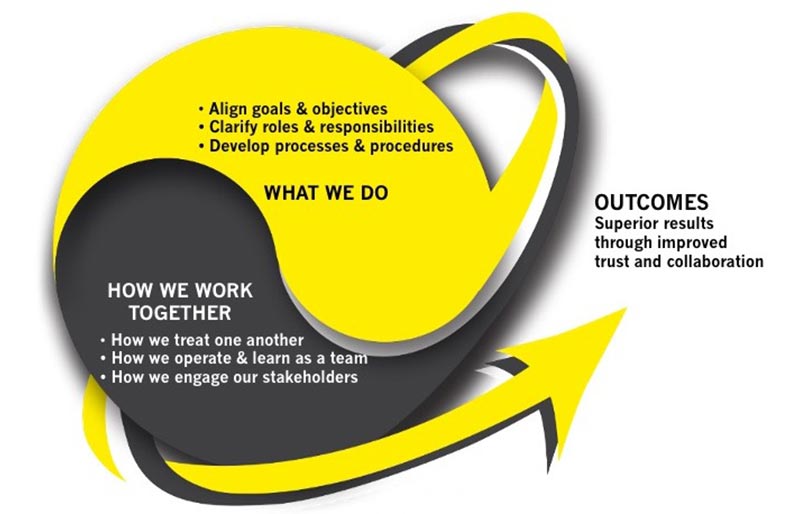
The Yin and Yang of Teams
Yin and Yang is an ancient Chinese philosophy. Essentially, there's a duality in life – light-dark, positive-negative – that is both complementary and interdependent. Every team faces this duality, especially in this virtual world. The best teams understand and embrace this phenomenon.
Top performing teams are constantly balancing and managing two complementary and interdependent drivers that can accelerate their performance. The first is about clarifying and aligning team members around What the team must do to succeed. The second is about addressing the culture and climate of the team – How members could and should work together to maximize their individual and collective potential.
We found that the best teams were diligent about managing this duality. Average teams were simply less attentive, and, as a result, much less effective.
Let's focus first on the What part of this duality. Our research revealed that top teams targeted three fundamental processes which enabled them to build the foundation for high performance.
-
Goals and Objectives - This first fundamental reflects a relentless concern with aligning the team's goals and plans with the business or with the vision and mission of their organization. We found that top teams were diligent about doing this. Plus, they often went beyond this standard. They built detailed action plans with specific timelines, which they updated periodically.
This was not a big surprise. We expected that having clear goals and plans would matter for team success – and it does. However, we know that goals and plans are moving targets; budgets and priorities are constantly changing. Members of top performing teams seemed to know this truth. They also knew that their performance and their legacy as a team was forever linked to the amount of discipline they applied toward updating and aligning their goals and plans as times changed.
They told us that this practice was integral – a habit. One member told us that her team regularly built project plan reviews into their timelines. Another described how his team continually checked in with members to ensure that they were still aligned and supportive of the team's goals and plans.
Members of average-performing teams did not spend as much time reviewing or updating their plans. They seemed to have less clarity about their team's goals. They also rated themselves as being less supportive of these goals.
-
Roles and Responsibilities - Members of top performing teams told us they allotted time to clarify team member roles, responsibilities, and accountabilities. They understood that teams are a complex web of relationships. Plus, members are often on multiple teams. They also knew that when a team first formed, the team's leader and its members needed to spend sufficient time clarifying what each member needed to do, who was accountable for what, and what the expectations should be for each member.
We even learned that some teams went deeper. They encouraged members to articulate what support each needed from one another to fulfill their responsibilities and maximize their contributions. This simple self-disclosure activity helped reduce the fear or anxiety that members may have felt initially. At the same time, it helped increase trust and collaboration.
-
Clear Processes and Procedures – In regard to this third fundamental, we learned that top teams were very diligent about developing clear and explicit team operating processes and procedures. These processes spelled out how the team would build meeting agendas; manage and document team meetings; share information and communicate with one another off-line; escalate issues that they could not resolve at the team level; solve problems proactively; and manage their relationships with the team's most important stakeholders.
Members understood implicitly that rigorous discipline was required to build and enforce these team processes and procedures. This attention to detail was a prerequisite for achieving high levels of innovation, collaboration, and breakthrough performance.
In short, the findings were clear. Top teams addressed these fundamentals. They developed a platform upon which they could build higher levels of team functioning and performance. Those who did not attend to these practices had difficulty achieving even average performance levels.
As these fundamentals are formed, embraced, and implemented, it's also important that team members pay attention to their team's climate and culture – the How. In Blog #2, Empowering Teams With Team Emotional Intelligence, we highlighted what we learned over and over again. Top teams developed a set of emotionally intelligent team norms that became habits. These agreed-upon team member norms, in turn, governed:
- How team members treat one another.
- How they operate and continuously learn as a team.
- How they manage the team's key stakeholders.
Vanessa Druskat, an Associate Professor of Organizational Behavior at the University of New Hampshire and the VP of Research and Development at Legacy Teams, spoke recently in a program sponsored by our partner, Educational Resource Systems, about the importance of team emotional intelligence. Here is one excerpt highlighting the creation of team norms.
Too often, underperforming teams focused more attention on one side of the equation vs. both. They were either less diligent attending to the What they needed to do as a team, or payed less attention to the team's climate and How they needed to work together. So, if we were to draw the following model depicting the way average teams perform, the What or the How side of this model would probably dominate this picture.

The best teams, on the other hand, adapt their focus based on the situation and the needs of the team. The lesson learned is that the What and How are complementary and interdependent. Teams cannot focus on one and exclude the other. It's a duality – the Yin and Yang of teams.
How are your teams addressing this duality? We at Legacy Teams can help your team(s) develop a more balanced perspective. It just might be the right time, especially while we are in the midst of this pandemic. Call us to find out more about our perspectives, and our team assessments and tools.
Happy trails and best wishes on your journey to success!